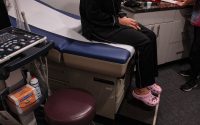Where Migrant Children Are Living, and Often Working, in the U.S.
Since 2021, migrant children have been traveling alone to the United States in record numbers: Nearly 400,000 children have crossed the southern border by themselves, most of them fleeing extreme poverty.
A Post-Pandemic Surge in Child Migrants
Nearly 750,000 migrant children have been placed with sponsors in the U.S. since 2012. More than half of those children have arrived since 2021.
Source: Analysis of data from the U.S. Department of Health and Human Services
The U.S. Department of Health and Human Services is responsible for placing these children with adult sponsors. While about a third of the children are reunited with parents in the United States, the rest live with other relatives or even strangers.
The New York Times analyzed H.H.S. data to determine the areas of the country with the highest concentrations of migrant children sent to sponsors who are not their parents.
Here is where they are ending up.
Where Migrant Children Were Sent to Live With Non-Parent Sponsors
Source: Analysis of H.H.S. data
Note: Data is from January 2015 through May 2023. The small number of cases where ZIP code data was not available are not shown.
Many of these unaccompanied migrant children are coming from rural areas in Central America that were crushed by the pandemic and its economic fallout. In the highlands of Guatemala, for instance, work dried up and food prices soared.
Where Child Migrants Are Coming From
Children from Guatemala and Honduras are coming in numbers that far surpass those of any other country.
Source: Analysis of H.H.S. data
Note: Years are reported as fiscal years.
A decade ago, most unaccompanied migrant children were released to their parents. But since 2017, that has changed: a majority of them now are going to non-parent sponsors. Those children are often expected to find work and help their families back home.
Social workers, teachers and lawyers who work with migrant children estimate that a majority of these children end up working full time, often in dangerous jobs that violate labor laws.
Migrant Children Placed With Sponsors Since 2017
Source: Analysis of H.H.S. data
Note: Data covers fiscal years 2017-22.
The Times obtained detailed data about where migrant children were released after successfully suing H.H.S. for a range of documents in October 2022.
The Times has used this database to identify small towns and urban neighborhoods in which disproportionate numbers of migrant children were living without their parents.
Some of the children living in these clusters have suffered serious injuries at work, like Marcos Cux, who was maimed at a Perdue Farms poultry plant in Virginia. Others have struggled to stay in school, like Carolina Yoc, who tried to balance ninth grade with a full-time night job packing Cheerios. Both were in ZIP codes where more than 90 percent of the migrant children were released to non-parent sponsors.
To help others study and report on this work force, The Times is releasing a 553,322-row dataset that details with new specificity where migrant children have ended up after coming to the United States on their own.


